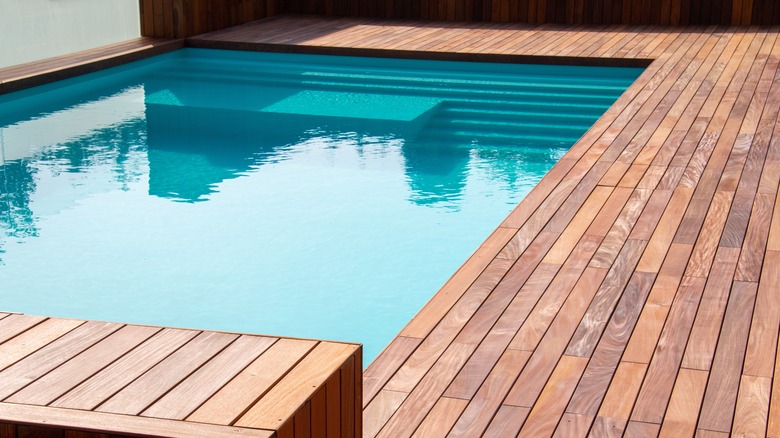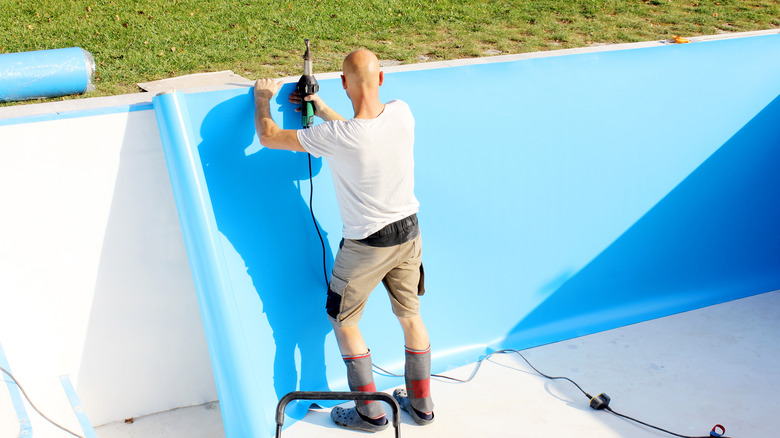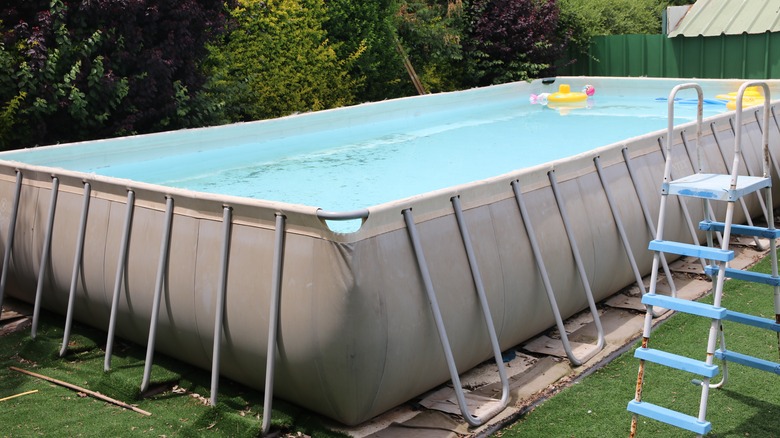Inground Vs. Above-Ground Pool: Which Is Right For Your Yard?
According to Pool Pricer, there are an estimated 8.5 million pools on residential properties in the United States. This only means that Americans love the relaxation and comfort elements that outdoor spaces provide — especially during the summer months — and the addition of a swimming basin can elevate this part of your home to a whole new level. If you've started to do any research at all into the addition of a pool on your property, then you know just how many factors play a role in the style and layout of the addition.
One of the main choices you'll have to make here is installing an above-ground basin or one that sunks into the landscape. In truth, there's no right answer about which swimming pool option is objectively best; instead, you'll need to think about which style best serves your needs and yard space.
Pool Pricer reports that inground swimming basins are always going to be more expensive to install than above-ground models. Cost can play a major role in any decision for the home, and so this feature alone may sway you toward an above-ground installation. But there are some major benefits to sinking and pouring an inground option that can't be found with above-ground pool models. In the end, the choice comes down to your specific needs.
The benefits of an inground pool
Inground pools provide a raft of benefits to homeowners. Starting with the visual appeal of a seamless deck and poured pool floor, the ability to customize and install an inground swimming basin is apparent, Pool Pricer says. Unlike above-ground pool installation, an inground swimming space can be designed and developed to suit any particular needs or interests that you might have. These basins can be as deep or shallow as you want, long or wide, and include additional amenities and features like a diving board, pool slide, or attached jacuzzi or hot tub.
Goodall Pools & Spas reports that an inground swimming space can augment the value of your property by a significant margin as well. The permanence of an inground pool installation makes it something that creates value, unlike many other outdoor addition opportunities. Finishing off the amenity with the inclusion of a new deck and other quality of life elements like an exterior entertainment system, lighting, and new patio furniture can tie together the space perfectly to give you a whole new outlook on outdoor living and add to the aesthetic and fiscal value of the home.
Inground pool drawbacks
It should be noted, though, that inground pools are more costly to install and far more expensive to renovate or repair later on. In addition, because an inground swimming space becomes integrated into the landscape around your home, it will require routine maintenance that goes beyond the water chemistry and other typical water feature upkeep. For example, according to pH Balanced Pool, a typical inground swimming basin will need to be resurfaced every three to seven years (or as many as 15 for more durable construction material). This means draining the pool and repairing the underlying surface to preserve the pool and the enjoyment you gained from its presence.
As well, inground pools are often larger than prefabricated, above-ground additions. This makes for a potentially more enjoyable swimming experience but also adds to the cost of chemicals, changes the way the flow of water ripples through the space (and, as a result, enhances the pattern of algae growth and other similar considerations), and adds to the physical maintenance in the form of brushing and vacuuming that you must perform routinely.
Above-ground model features that make a difference
Above-ground pools are a great alternative to the large-scale construction project that brings an inground basin to a home. Above-ground pools are often very simple to install, requiring little to no digging, depending on the depth you're looking for. For instance, a home built on a raised foundation might take advantage of the added height that an above-ground basin offers by simply tying it into an existing raised deck behind the home.
While older above-ground swimming spaces often made use of a more practical aluminum, steel, or resin material, Organize With Sandy notes, that could be seen on the inside and the outside, new models have started to incorporate more elegant design additions to the exterior. Pool Pricer reports that modern above-ground swimming basins can be made with a wood finish or other style elements that fit your existing exterior decking and landscape design for a more complex aesthetic finish. Also, because of the smaller overall footprint of an above-ground pool, you can use this addition in virtually any sized yard to great effect.
The negative aspects of an above-ground pool
Of course, there are also some drawbacks to installing an above-ground pool. Even though great strides have been made to create a more luxurious look and feel for this type of addition, Pool Pricer notes that above-ground swimming spaces are often designed to tie in with decking and other elements to make the water feature appear like an in-ground installation.
Customization is also an issue when it comes to above-ground pool installations. While inground swimming basins can be designed with any shape, layout, or features that a homeowner desires, above-ground models are typically round (as a natural strengthening against the outward pressure of the water that will live within the environment) and lack personalization beyond diameter and construction material selections.
Pool Pricer also suggests that above-ground pools can reduce the property value. For example, suppose you're thinking of selling your home. In that case, it may actually make more sense to pay a professional to remove the installation than to sell it with the above-ground basin occupying space in your backyard.




